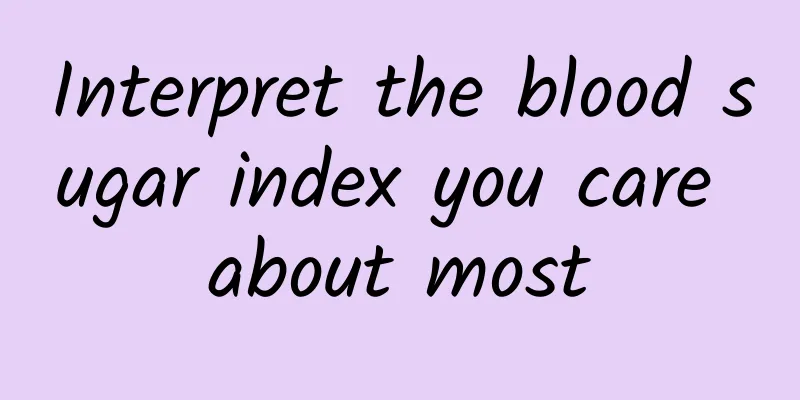Interpret the blood sugar index you care about most

|
Recently, there have been reports online that new standards for diagnosing diabetes blood sugar levels have been introduced, and that fasting blood sugar levels and postprandial blood sugar levels have been relaxed compared to the past. Is this news true? What do the various blood sugar test indicators reflect? Are your indicators up to standard? Are the current treatment methods appropriate? This article evaluates the above news and answers readers' questions. The Internet claims that blood sugar standards have been relaxed compared to before, which is not true Liu Hong, chief physician of the Department of Endocrinology at the First Affiliated Hospital of Guangxi Medical University, pointed out that according to the "Guidelines for the Prevention and Treatment of Type 2 Diabetes in China" newly published by the Chinese Medical Association in 2020, although the blood sugar diagnostic criteria for diabetes in my country are different from before, fasting blood sugar and postprandial blood sugar have not changed compared with before. Online reports that blood sugar has been relaxed compared with before are not true. At present, it is still based on the diabetes glucose metabolism classification proposed by the World Health Organization in 1999; it is just that "glycated hemoglobin ≥ 6.5%" has been added as a supplementary diagnostic criterion to the original diagnostic criteria. In other words, in addition to real-time blood sugar, more attention is paid to the determination of the average blood sugar level in the past 2 to 3 months. In simple terms, the latest diagnostic criteria for diabetes are the typical symptoms of diabetes: thirst, polydipsia, polyuria, polyphagia, unexplained weight loss, plus any one of the following related blood sugar indicators: (1) random blood sugar ≥11.1 mmol/L; (2) fasting blood sugar ≥7.0 mmol/L; (3) two-hour postprandial blood sugar ≥11.1 mmol/L; (4) glycosylated hemoglobin ≥6.5%. "If a blood sugar index is found to be elevated during a physical examination, but there are no typical symptoms of diabetes, a re-examination is required on another day to confirm. If the blood sugar index is still elevated after re-testing, even if there are no typical symptoms of diabetes, it will still be diagnosed as diabetes," said Liu Hong. The blood sugar control target for the elderly can be appropriately relaxed according to actual conditions The diagnostic criteria for elderly diabetes are the same as those for general diabetes, but only those aged ≥65 years can be diagnosed with elderly diabetes. However, when treating diabetes in the elderly, the blood sugar control target can be appropriately relaxed according to the actual situation. For example, for general diabetic patients, the control target for fasting blood sugar is 4.4-7.0 mmol/L, and postprandial blood sugar is controlled below 10.0 mmol/L; for elderly diabetic patients, fasting blood sugar can be relaxed to 5.0-8.3 mmol/L. Glycated hemoglobin should be controlled below 7% for diabetic patients, and can be appropriately relaxed to 7.5%-8.0% for elderly diabetic patients. Are your blood sugar levels up to standard? Some people may ask, which is more accurate, fasting blood sugar or postprandial blood sugar? In fact, blood sugar indicators at each time point have their own significance, and different groups of people have different focuses on different time points for monitoring. There is no such thing as which is more accurate. Fasting blood sugar is the blood sugar measured before breakfast the next day after not eating for at least 8 hours. It is tested when the blood sugar level is very high or there is a risk of hypoglycemia. Postprandial blood sugar is measured 2 hours after eating, starting from the first bite of food. It is suitable for people with good fasting blood sugar control, glycosylated hemoglobin not meeting the standard, and those who need to understand the impact of diet and exercise on blood sugar. Bedtime blood sugar is the blood sugar measured before going to bed. Patients who inject insulin, especially those who inject before dinner, should test it. Nighttime blood sugar is generally measured at 2 to 3 a.m. It is used when insulin therapy is close to reaching the target, but fasting blood sugar is still high; or when nocturnal hypoglycemia is suspected. What is Glycated Hemoglobin Glycated hemoglobin (Hb Alc) can reflect the average blood sugar level in the past 2 to 3 months and is the "gold standard" for clinical evaluation of long-term blood sugar control. The normal reference range is 4% to 6%. Generally, diabetic patients should control their blood sugar level below 7%. The limit can be relaxed appropriately for patients who are older, have a long course of disease, or have complications. A large number of studies have shown that excessive glycated hemoglobin is closely related to the risk of diabetic complications. Patients whose glycosylated hemoglobin levels do not meet the target should be tested every 3 months, and once every 6 months after reaching the target. However, this indicator has a delayed effect on the evaluation of the effect of the treatment plan after adjustment for diabetic patients. Glycated albumin has significant advantages in evaluating the efficacy of diabetic patients after treatment adjustment and identifying stress hyperglycemia (transient blood sugar increase after major physical and mental trauma). However, it cannot accurately reflect the characteristics of blood sugar fluctuations. The higher the value of the new indicator "Percentage of time within the glucose target range", the more stable the blood sugar In recent years, continuous glucose monitoring technology has continued to develop and has gradually become one of the methods of blood glucose monitoring. The simplest and most intuitive indicator is the time in the glucose target range (TIR), which refers to the time or percentage of glucose in the target range (usually 3.9-10.0 mmol/L) within 24 hours. When measuring, you need to use a dynamic blood glucose monitor. The sensor is "sticked" on the arm, and the probe is implanted subcutaneously. The blood sugar level is measured by collecting the glucose concentration of the subcutaneous tissue fluid. Just bind a smartphone and scan the probe through the supporting App to find out the TIR value. The higher the TIR value, the longer the blood sugar meets the standard, the more stable the blood sugar control during the monitoring period, and the lower the risk of cardiovascular events related to type 2 diabetes. This monitoring method is suitable for people with poor blood sugar control and those who are prone to hypoglycemia. The new guidelines have new highlights on the applicable conditions of various hypoglycemic drugs Highlight 1: The 2020 edition of the "Guidelines for the Prevention and Treatment of Type 2 Diabetes in China" states that metformin is the first-line drug for type 2 diabetes and the basic drug in combination therapy. According to the 2022 edition of the American Diabetes Association (ADA) Diabetes Diagnosis and Treatment Criteria, appropriate drug treatment should be selected based on the patient's specific circumstances, and metformin is not necessarily the first-line treatment. However, Liu Hong believes that this does not negate the therapeutic effect of metformin. In most cases, metformin and active lifestyle interventions should still be selected as first-line treatments. The second highlight emphasizes early combined treatment. For patients with type 2 diabetes who have cardiovascular disease and chronic kidney disease, the "221 regimen" is recommended, which refers to the combination of metformin, SGLT-2 inhibitors (empagliflozin, dapagliflozin, ertogliflozin) and GLP-1 receptor agonists (liraglutide, benaglutide) as the first-line treatment option. Highlight 3: The "Guidelines for the Diagnosis and Treatment of Elderly Diabetes in China (2021)" states that elderly diabetic patients with glycosylated hemoglobin>10%, or with symptoms of hyperglycemia (such as thirst, polyuria), or fasting sugar>10 mmol/l, can use short-term insulin treatment. In the past, it was generally recommended to start insulin treatment when hemoglobin>9%. Liu Hong believes that the new guidelines emphasize the safety, efficacy, simplicity and patient compliance of insulin use. Highlight 4: Treat obesity first and then lower blood sugar. It is recommended that obese and type 2 diabetic patients participate in an intensive lifestyle training program for at least two weeks. For obese diabetic patients with good pancreatic islet function, it is necessary to strengthen lifestyle intervention training and perform 150 minutes of moderate-intensity exercise (such as brisk walking) per week. Individualized treatment can be combined with traditional Chinese medicine The new guidelines emphasize a patient-centered treatment strategy. Liu Hong believes that cooperating with traditional Chinese medicine is an important aspect. Traditional Chinese medicine treatment of diabetes requires syndrome differentiation and treatment. Commonly used classic prescriptions include Shenqi Pills, Xiaoke Recipe, Liuwei Dihuang Pills, Baihu Jia Renshen Decoction, Gegen Qinlian Decoction, etc., combined with acupuncture, auricular acupoint application, and Chinese medicine external washing. At the same time, oral hypoglycemic drugs or insulin treatment can achieve good results. |
<<: Is low-concentration atropine eye drops a miracle drug for myopia?
>>: Science 60s丨Some tips to improve sleep quality
Recommend
What to do if the placenta is low during pregnancy
Women will experience various symptoms after beco...
Early symptoms of uremia in women
Many female friends have to bear multiple roles. ...
Will cervical erosion cause lower abdominal pain?
A woman is a flower, blooming in the spring breez...
What are the precautions after hydatidiform mole surgery?
After the hydatidiform mole surgery, it is recomm...
Took vitamin b2 and mold was cured
After a woman's reproductive system is infect...
What are the tips for buying taro? How to cook taro at home
Generally speaking, it is almost impossible to te...
What is the cost of minimally invasive fallopian tube unblocking surgery?
Among the causes of female infertility, fallopian...
How to reduce abdominal fat during pregnancy
Ways to lose belly fat: 1. Avoid sitting or lying...
Color Doppler ultrasound picture of the fetus at three months
The early pregnancy needs to come to an end in th...
What are the benefits of eating beetroot? What is the best juice to make with beetroot?
In life, you may be familiar with beetroot. It is...
What medicine should I take for uterine hypertrophy?
Uterine hypertrophy is a common gynecological dis...
Feeling a foreign object in the chest
If you have chest pain, it is likely caused by br...
Gynecological inflammation self-examination table pictures
Nowadays, many female friends are confused by gyn...
What does a female internal examination check?
Many pregnant women need to undergo internal exam...
What is the cause of cervical congestion? Common reasons include:
Cervicitis can often cause cervical congestion. T...









